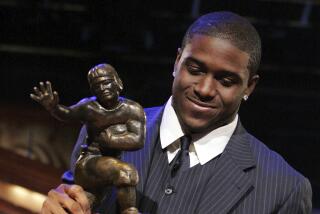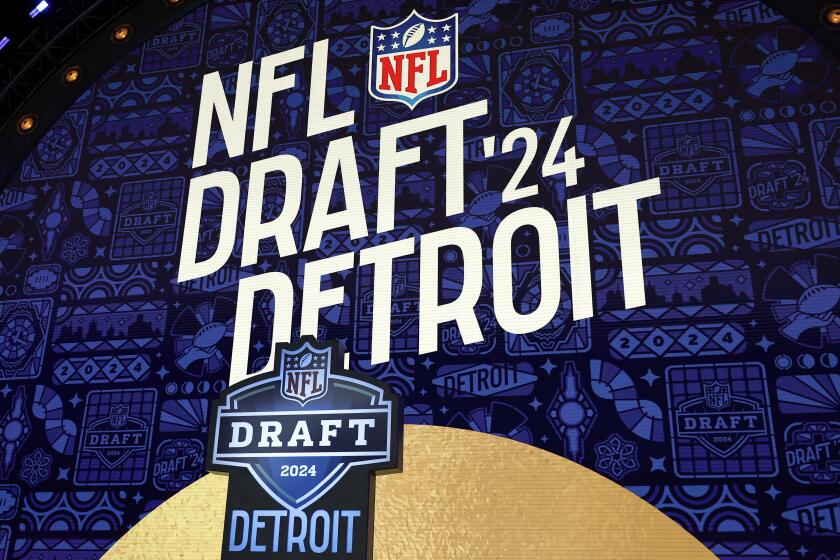You can tell it’s an Arizona Cardinal home game by the absence of hometown fans in the stands
TEMPE, Ariz. -- He has been razzed by Cowboy fans, rankled by Cheeseheads and ridiculed by Bronco boosters, but Burt Newmark isn’t backing down.
He’s standing by his Arizona Cardinals through thin and thinner.
“I’ve thought about giving up my season tickets every single year I’ve had them,” said Newmark, who has had two 45-yard-line seats at Sun Devil Stadium since the Cardinals moved to Arizona in 1988. “I always wind up keeping them.”
There’s a warped camaraderie, he said, among those people who stick with a franchise that has had .500 or worse records in 16 of 17 seasons, has one playoff victory since 1947 and has drawn thousands of opposing fans to every home game because the tickets are abundant, the skies are often cloudless, and the victories come easy.
On Sunday, the Cardinals suffered a 17-12 loss to St. Louis in which they blew a final shot at the end zone with a game-ending penalty for illegal procedure. Just another frustrating twist for an 0-2 club perpetually searching for a way to turn the corner.
Newmark, a native New Yorker who was born and raised in the Bronx, became a Cardinal fan because he loves the NFL and could never get a ticket when he lived in New York, Pittsburgh and Washington.
“I’m a huge fan of the Yankees and the Cardinals,” said Newmark, an engineering consultant who lives in Albuquerque and flies to Phoenix for every home game. “The Yankees are the best franchise in the history of sports, and the Cardinals are the worst. It’s like they go out of their way to lose.”
But members of the Cardinal organization say those days are over, even if it isn’t immediately apparent in the standings. Beginning next season, the team will be playing in a spectacular new stadium in Glendale, Ariz., with a retractable fabric roof, gauze-like enough to let the sunlight through, and a natural-grass field that slides in and out of the $450-million venue on a gigantic tray. The Cardinals made an original investment of $85 million in the stadium, and the rest will be paid with tax-financed bonds.
“It’s going to be the most incredible NFL facility that’s ever been built,” said Ron Minegar, the club’s vice president of marketing and sales. “There’s a mind-set here that we expect success, and we’re preparing for that.”
There is some evidence of that. The Cardinals have drafted well the last two years, and they’re paying a competitive salary for a proven coach, Dennis Green, who makes $2.5 million a year. That’s a departure from the past, when the Cardinals ranked at or near the bottom of the league in various salary categories.
Consistently last in the league in total attendance, the Cardinals are the only NFL team -- aside from the displaced New Orleans Saints -- playing in a college football stadium. Their new place will play host to the Super Bowl in February 2008 and is the only closed-roof venue in the Western United States with the capacity to accommodate a crowd of at least 40,000.
It remains to be seen if the Cardinals will be able to fill those seats, though, once the novelty of their new stadium wears off. Typical of a Cardinal home game, the upper deck Sunday was maybe one-third filled, and there were some 38-row sections on the sunny east side with fewer than 10 people sitting in them.
“I’ve seen so many stretchers over the years going down one after another -- especially the fans of other teams that don’t understand about the heat,” said Don Brown, one of six spectators sitting in Section 230, overlooking an end zone from the upper deck of the stadium’s northeast corner, where the aluminum bleachers can get stove-coil hot. He too has had season tickets since 1988.
“You don’t have to put up with many opposing fans,” Brown said of his lonesome vantage point.
“And,” he added, “I’ve got all the leg room I want.”
*
Forget about the keys to victory. The Cardinals would have been happy to find the keys to their building.
The year was 1993 and Arizona was hoping to woo free-agent quarterback Joe Montana to the Valley of the Sun. Team officials wined and dined him, said all the right things, then brought him back to team headquarters to give him a tour of the place. The gate was locked, though, and no one could produce a key. Montana laughed it off and wound up signing with Kansas City.
Only Montana knows for sure if he was serious about the Cardinals or merely looking to get more money from the Chiefs. But the awkward end to his Arizona visit was just another in a long line of memorable gaffes by a star-crossed franchise.
Pete Kendall has his own lockout story. He played guard for the Cardinals from 2001 through 2003 and liked to study film at team headquarters after most everyone had gone home. He requested a key but never got one. Instead, every time he showed up, security put him through the paces.
“It just became more of a hassle than it was worth,” said Kendall, who now plays for the New York Jets. “I started to feel like I wasn’t wanted at that time. I just thought it was an unnecessary inconvenience.”
The club has reeked of losing for decades.
Former safety Lorenzo Lynch tells about the time his face mask broke in the second half of a road game. The Cardinals were trailing at the time and looked to be on their way to another loss. Lynch approached an equipment man and asked him to replace the bracket on his helmet to secure the mask. No, he was told, all that stuff already had been packed away on the bus.
Like the Cincinnati Bengals, who used to have laundry carts in the locker room for communal socks and jockstraps, the Cardinals were notoriously cheap. Eric Hill, who spent nine seasons as their middle linebacker, recalls players receiving one pair of shoes and one pair of socks to last the entire season. Run-of-the-mill players made a minimum salary of $60,000 at the time, so shoes were not an inconsequential expense.
“Many days I’d see guys arguing with the equipment guy at the cage,” Hill said. “It was like, ‘Hey, man, give me a pair of socks.’ And the equipment guy was like, ‘Well, where are the socks we gave you?’ It was, ‘They must have fallen out of my bag.’ ”
Hill recalled how, in his first week as a pro, he was so impressed with the catered lunch served to the players. Impressed, that is, until he realized a portion of the cost was deducted from his paycheck.
Hill heard from friends around the league that other teams were more free-spending, but he didn’t discover it firsthand until he played for the St. Louis Rams and San Diego Chargers.
“When I left,” he said, “my whole world opened up for me.”
There was another drawback to playing for Arizona that the Cardinals simply couldn’t control: A heat so intense and merciless that, as former Cardinal center Ed Cunningham said, “it felt like you had a microwave oven going full blast under your pads.”
The Cardinals opened this season on the road, just as they had in 16 of the previous 17 seasons. The fewer blistering-hot, early-September games the better. Fans at the game get continual reminders over the public-address system to keep drinking water. It’s not uncommon in late-summer games to see the large thermometer on the sideline pegged past 120 degrees.
Cunningham said the worst part wasn’t playing in the heat, it was taking breaks on the bench and gulping breaths of that lung-searing air. He lost 14 pounds one afternoon.
“When you’d sit down, your pads would ride up and lift off your shoulders,” he said. “That hot, moist air that comes from inside your shoulder pads and up your face is painful.”
*
When is a home game not really a home game?
If you play for the Arizona Cardinals, you know the answer.
Because the season-ticket base is so low -- it hovered between 20,000 and 30,000 for years -- the crowd at Sun Devil Stadium is often pulling just as hard for the visiting team to win. That has been a big source of frustration for a lot of Cardinals over the years.
“We were having a hard enough time winning games,” Kendall said. “We shouldn’t have to use a silent snap count in our own stadium, but that was a fact of life.”
So it was especially infuriating for Kendall and his teammates when they discovered the Cardinals were marketing their team in other cities, beckoning fans of other teams to come to Arizona for a game. Can’t get tickets to see the Green Bay Packers at Lambeau Field? Come see them play in Tempe. That didn’t sit well with those players toiling in Arizona.
“That was troubling as a player,” Kendall said. “I understand from a business point of view. In the short term, there are benefits to selling that stadium out. But as a player, being there trying to build something for the future, winning games at home would have paid bigger dividends.”
In 2003, the St. Louis Post-Dispatch reported that 25,000 Ram season-ticket holders had received a mailing from the Cardinals with information about buying tickets to see their team play at Arizona.
Minegar, the team’s sales director, said the Cardinals were working hard to grow their fan base but selling tickets in other NFL cities “is not part of our go-forward plan.”
Cardinal owner Bill Bidwill, regarded as a miser by many and a misunderstood philanthropist by some, has said for years that the revenue generated by a new stadium will help the franchise become more competitive.
“We’re in the business of winning,” he told the Arizona Republic in 2001. “You want to be able to do everything you can to help your team do that, make the situation as good as you can for them. We want to win. We would like to get into a new building and have some of the sources of income that other teams are using to attract and keep their own people.”
The Cardinals intend to model a turnaround after that of the Tampa Bay Buccaneers, who went from perennial loser to Super Bowl champion, before taking a few steps backward in the past two seasons.
Loyal Cardinal fans can only hope.
“Come the time the Cardinals start winning, I’ll be able to say, ‘I was there all along,’ ” said Brown, the fellow with all that elbow room in the upper deck. “I’m a true fan. Either that, or I’m not real smart.”
*
(BEGIN TEXT OF INFOBOX)
Plenty of seats
Average game attendance for the Cardinals since they moved from St. Louis to Arizona, making Sun Devil Stadium their home. The stadium has a capacity of 73,379. The Cardinals drew 45,160 for Sunday’s home opener against St. Louis.
Year Average1988 59,1171989 43,1501990 43,4571991 42,0961992 39,9201993 45,3081994 62,1661995 47,5391996 40,0641997 47,4431998 52,4071999 58,1692000 48,3412001 38,4152002 40,9102003 36,0622004 37,553
More to Read
Get our high school sports newsletter
Prep Rally is devoted to the SoCal high school sports experience, bringing you scores, stories and a behind-the-scenes look at what makes prep sports so popular.
You may occasionally receive promotional content from the Los Angeles Times.







